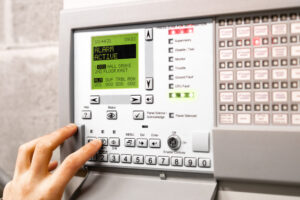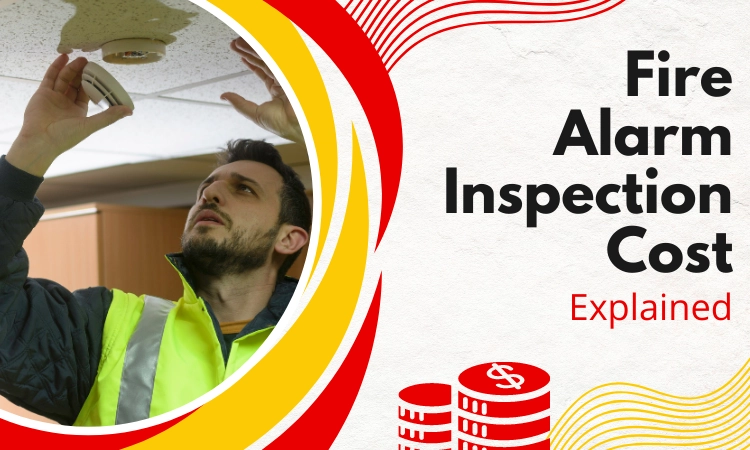Ever experienced a false fire alarm or missed alarm in dire moments? We hope you didn’t. Because it’s definitely not a pleasant experience to have.
But you may face it if you’ve ignored the regular fire alarm inspection. They are not very costly either. So, how much does the fire alarm inspection cost?
Annual fire alarm inspections can cost about $200 or more. As for monthly inspection, $50-$100 is the common price range. But the amount heavily depends on how many devices are to be tested. The facility and the complexity of the system also determine the total cost.
That’s the sneak peek. To learn more details on the inspection cost dive into our discussion. Let’s begin!
Cost Of Fire Alarm Inspection

Annual fire alarm inspection costs about $200 or more from licensed technicians. monthly fire inspection may cost you around $50-$100. But the cost range isn’t constant and depends on a few other things.
For example, how big the safety system is and what devices are being used. Also, the type of devices you use. Let’s see the details on how they affect the inspection cost.
Device Count:
The inspection cost greatly depends on the device count in your fire alarm system. A smaller system only requires some basic testing that is inexpensive.
But if you’re fire alarm system consists of 50 to more devices, it’ll be expensive. Devices like audio visuals, alarm pull stations, smoke, duct, and heat detectors cost a lot.
They’ll cost you about $500-$1,000. These are the basic devices containing the fire alarm system. Now, big apartments or factories require more of these same devices.
A facility system containing 500 of these same devices will cost about $7,000-$8000. This is the amount of the inspection. Missing or broken devices will increase the cost by 10-15% on average.
Device Type:
Some of the devices raise the cost of the inspection significantly. For example, the water flow and tamper switches. It’s part of the sprinkler system inspection.
The process also includes checking the supervisory devices. Altogether it raises up to 20% of the total cost of the fire alarm inspection.
Devices like duct detectors and smoke detector sensitivity take a lot of time to inspect. Air and gas detectors also make it to the list. Inspection of these devices consists of running a few tests.
Which is why they’ll cost more than regular device inspections. Another significant mention is the elevators with fire alarm facilities. They require exclusive inspection and testing.
If it has a reset key, the process becomes easier for professionals. But in case you don’t have it serviced, it’d take a lot of time. Which will raise the inspection cost as well.
Facility & Accessibility of Device:
The type of facility the fire alarm devices have affects the inspection cost. For devices with complicated settings takes longer to check. New updates in fire rules or renovations may also become a challenge.
As a result, the inspection process may take longer. To finish the work faster they may have to work off-hours. This increases the cost of labor. The positioning of the devices also plays a part in it.
Let’s say, the smoke detector is installed at the top of the atrium. Depending on the height, they’ll require a scissor lift. And renting a scissor lift for a day costs about $600.
So, better not install them so high. But don’t install them too lower either. Unlike how CO monitors are installed they can’t be installed so lower.
Although we broke it down into three major criteria, more factors affect the whole process. It’s tough to tell how much will the inspection cost you without knowing the system.
So first, review the available information about the devices in your fire alarm system. Learn about the facilities and the intricacies. It’ll help you figure out whether the system needs complicated or basic inspection.
Then it’ll be easier to guess the estimated cost of the inspection services.
How Long Does A Fire Alarm Inspection Take?
Fire alarm inspection typically takes 1 hour to a couple of days. It depends on the complexity of the system. For large facility systems, inspection takes more time as the device count is higher.
Technicians will be able to give you an estimated time frame upon seeing the system. While it may be inconvenient sometimes it is a necessary duty to be performed.
So, better not to skip it or rush it.
Why Inspect Fire Alarm System?

Fire alarm inspection is significant for the following reasons:
Safety of Life & Properties:
Nothing is more important than your life’s safety. Fire alarm system saves lives during emergencies. Giving routine checks will keep your mind in peace that it’ll notify any fire hazards.
The system works quickly to keep any damage to a minimum. An uninspected alarm system might fail to do so. Therefore, it must not be ignored at any cost.
Maintain Code Compliance:
No matter which state you live in, the NFPA protocols must be maintained. According to National Fire Alarm & Signal Code by NFPA-72, fire alarm inspections are necessary.
Not only the NFPA, the local regulatory agencies, insurance companies, and equipment manufacturers require it. They need the yearly fire alarm inspection reports.
Failing to do so has consequences like fines or penalties for not being compliant.
Securing Insurance:
The inspection results are necessary for securing insurance. So, you can avoid the worst in case any properties get damaged. The inspection reports will prove your claims to be true.
Prevents False Alarm Signals
A false fire alarm signal can cause chaos within a minute. Your business operation or any routine work will get disrupted unnecessarily. If you leave the facility unchecked for too long this problem may arise.
To avoid such situations, it’s necessary to keep the detectors and the internal devices checked. Don’t forget to reset the emergency lights as well.
What Happens If Your Fire Alarm System Fails The Inspection?
Violation of the fire code may lead to failure in fire alarm inspection. If the inspection becomes a failure the work schedule in the place might get halted.
The common reason for such failures happens due to the following reasons-
- Exposed wiring
- Missing address or hidden suite number
- Misuse of extension cords
- Clogged fire hydrant
- Expired extinguishers
- Blocked fire exits
Usually, when the inspection fails, the root cause gets addressed and is fixed immediately. For example, any failed devices are to be replaced promptly.
So that, the rest of the inspection goes smoothly and passes the final inspection. But if the repair is not possible immediately then a report is made.
It mentions the reason for the failure and is sent to the owner. It is the owner’s responsibility to fix them and schedule a re-inspect date. That way, the failed test doesn’t get reported.
The scenario is a little different if a substantial portion of the system fails the test. Customers are given 8 hours to fix the problem and get the test passed.
After the allotted time passes, with no progress the local fire department gets involved. They decide how to approach the problem. In extreme cases, they can close the establishment until the problem is fixed.
Fire Alarm Maintenance Guidelines
You can follow the mentioned procedure here for fire alarm maintenance.
- Proceed with a weekly test to see if the fire suppression system is working properly.
- Check all the detectors, especially the smoke and flame detectors. Make certain that the alarm sensors are calibrated.
- Examine the alarm sounder and transmission signals for any disconnections.
- Make notes on any defects in the system and have them fixed.
- For systems with multiple zones, try to inspect more than a single zone per week.
- Inspect the battery condition of the alarm devices. Replace if needed.
- Sign up for annual, semi-annual, or quarterly fire alarm inspection tests. Have the professionals review your establishment’s fire alarm system.
- Collect a certificate of passing all the inspection tests.
- Check the fire exit doors once in a while. Make sure there’s no obstruction on the way. Also, keep the emergency exit light on. If there’s any automatic release door make sure it’s working properly.
Frequently Asked Questions (FAQs):
What are the three states of a fire alarm system?
Normal, Alarm, and Trouble are the three states. A normal state indicates that all devices, wiring, and circuitry are functioning properly. Also, there’s no active alarm at the moment. The alarm state indicates an active alarm. A trouble state appears when there’s any short wiring happens in the circuits.
How many types of fire alarm panels are there?
There are four types of fire alarm panels. But the main two types are addressable and non-addressable panels. In addressable panels, all components are monitored individually. They come with distinct addresses. On the contrary, the non-addressable panel has zones.
How many types of smoke detectors are there?
There are three types of smoke detectors. Ionization, photoelectric, and dual smoke detectors. Ionization detectors use ions or radioactive particles to detect smoke. The photoelectric smoke detector uses a beam of light to detect them. Dual is the combination of both systems.
End Note
Now you have the idea of how much the fire alarm inspection cost is gonna be. You also know what factors determine the cost increases. To know further details talk to the technicians about your fire alarm facility.
Since they’ll know it best. Don’t forget to re-schedule an inspection date in case you’ve missed it. Stay happy, stay safe!

